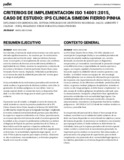Please use this identifier to cite or link to this item:
https://repository.unad.edu.co/handle/10596/31733Full metadata record
| DC Field | Value | Language |
|---|---|---|
| dc.contributor.advisor | Plazas Gomez, Yon Alexander | - |
| dc.coverage.spatial | ccav_-_neiva | spa |
| dc.creator | Losada Pedroza, Jorge Horacio | - |
| dc.date.accessioned | 2020-03-17T19:01:56Z | - |
| dc.date.available | 2020-03-17T19:01:56Z | - |
| dc.date.created | 2020-03-05 | - |
| dc.identifier.uri | https://repository.unad.edu.co/handle/10596/31733 | - |
| dc.description.abstract | En Colombia, el sistema de salud actual atraviesa una crisis que ha afectado signicativamente a los usuarios por las instituciones prestadoras del servicio de salud, dado por distintos factores como la corrupción, el incumplimiento de normas y los conictos entre los intereses de diversos actores del sistema debilitan la legitimidad de este último, atomizan la cooperación y cohesión de los actores y fortalecen el interés particular (Suarez Rozo, Luisa Fernanda; Puerto-García, Stephanie, 2016).Dada la problemática en el sistema de salud, la calidad del prestador del servicio pone en riesgo la salud pública. En las actividades de las instituciones prestadoras del servicio de salud, conlleva a la generación de distintos residuos, entre ellos, la generación de residuos peligrosos, lo cual, deben tener un manejo especial, desde su recolección hasta su disposición final dado a su alto índice de riesgo para la salud y para el medio ambiente. El presente caso de estudio va dirigido al sector de sistema de salud, teniendo en cuenta los procesos productivos de la IPS Clínica Simeón Fierro Pinha, basado en la Norma ISO 14001:2015. La información respectiva que se ha logrado investigar empleando la revisión ambiental inicial (RAI) donde partimos para identicar los aspectos e impactos ambientales en la Clínica, posteriormente, un resumen ejecutivo del sistema de salud, el contexto general de la entidad, se da a conocer la problemática ambiental y se elabora el diagrama de ujo de los procesos productivos de la Clínica, se desarrolla la matriz de aspectos e impactos ambientales, se determina el alcance de la implementación del SGA, seguidamente, se determina la normatividad y legislación legal vigente, en el ciclo PVHA se plasma aspectos para mejora continua , nalmente se dan conclusiones, recomendaciones y se formulan preguntas basado en el caso de estudio. | spa |
| dc.format | ||
| dc.title | Criterios de implementación ISO 14001:2015, IPS Clinica Simeon Fierro Pinha | |
| dc.type | Diplomado de profundización para grado | |
| dc.subject.keywords | Ambiental | spa |
| dc.subject.keywords | Procesos | spa |
| dc.subject.keywords | Salud | spa |
| dc.description.abstractenglish | In Colombia, the current health system is going through a crisis that has significantly affected users by institutions Health service providers, given by different factors such as corruption, non-compliance with regulations and conflicts between the interests of various actors in the system weaken the legitimacy of the latter, atomize the cooperation and cohesion of the actors and strengthen the particular interest (Suarez Rozo, Luisa Given the problem, Fernanda Puerto-García, Stephanie, 2016) in the health system, the quality of the service provider puts public health at risk. In the activities of the institutions providing the health, leads to the generation of different wastes, among them, the generation of hazardous waste, which must have a special handling, from collection to final disposal given its high risk index for health and for the environment environment. The present case study is directed to the sector of health, taking into account the production processes of the IPS Simeón Fierro Pinha Clinic, based on ISO 14001: 2015. The respective information that has been investigated using the initial environmental review (RAI) where we participate to identify the environmental aspects and problems in the Clinic, later, an executive summary of the health system, the general context of the entity, the environmental problem is disclosed and it is elaborated the flow diagram of the production processes of the Clinic, is develops the matrix of environmental issues and problems, determines the scope of the EMS implementation, then the regulations and legal legislation in force are determined in the PVHA cycle shapes aspects for continuous improvement, nally conclusions, recommendations and questions are asked based on the case study. | spa |
| Appears in Collections: | Diplomado en Gerencia del Sistema Integrado de Gestión en Seguridad Salud Ambiente y Calidad HSEQ | |
Files in This Item:
| File | Description | Size | Format | |
|---|---|---|---|---|
| Jhlosadap.pdf | 547.12 kB | Adobe PDF |  View/Open |
Items in DSpace are protected by copyright, with all rights reserved, unless otherwise indicated.
